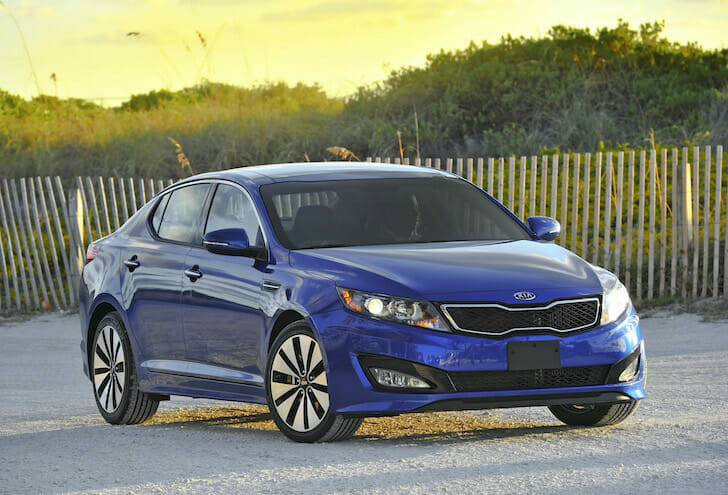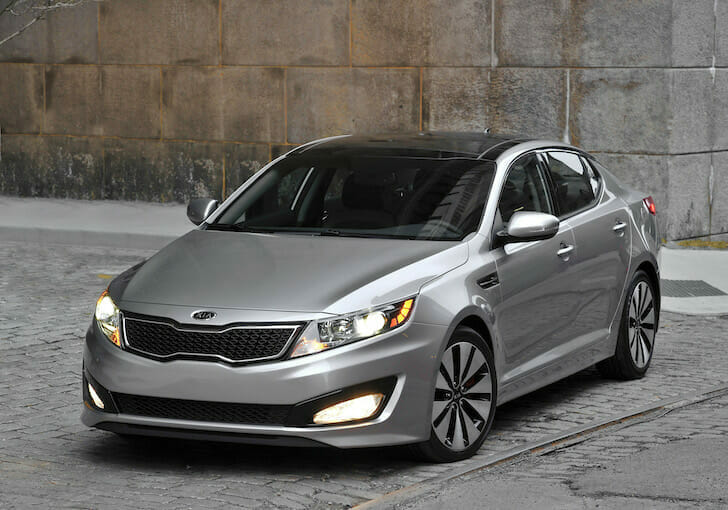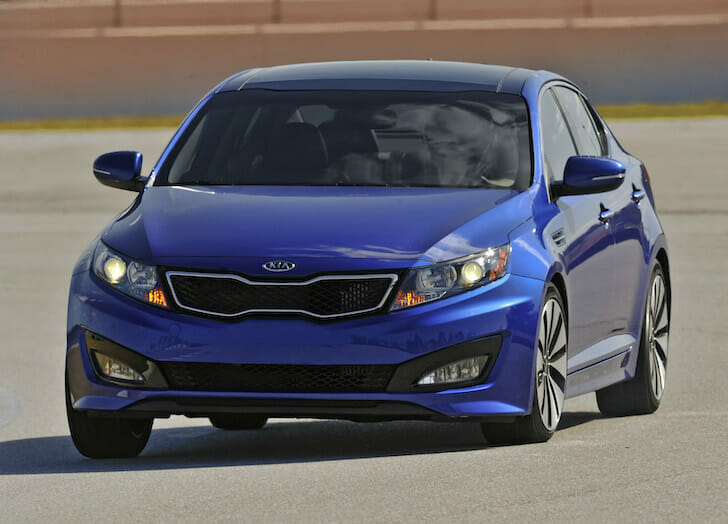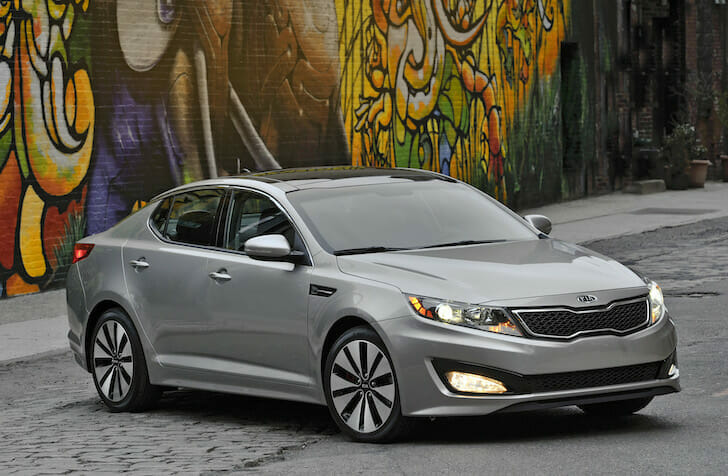Achieving a max 39 mpg, the Optima’s impressive performance and fuel efficiency are overshadowed by class-action lawsuit and giant fines.

Key Points
- The 2.0L turbo is the most thrilling engine choice in the 2011 Optima, without much of a loss in fuel efficiency. The 274 hp engine is peppy and offers added torque from the turbocharger.
- The 2.4L is fuel-efficient as long as you service the engine regularly to avoid the known recall for engine seizing. Because of the known recall, we wouldn’t call it reliable.
- The hybrid offers the most impressive fuel economy and still has enough power to be a strong choice for shoppers who like fuel savings and want to yield safely on the highway.

2011 Optima Engines Offer Performance, Fuel Efficiency, and Win Awards
The 2011 Kia Optima offers staunch performance in a family sedan, with great fuel efficiency. The 2.4L inline four-cylinder offers 200 hp at 6,800 rpm and 186 lb.-ft. of torque at 4,250 rpm and achieves a respectable 24 mpg when around town and 34 mpg at highway speeds. In the higher EX Turbo and SX trim levels, Kia outfitted the Optima with a 2.0L turbocharged inline four-cylinder. The turbo more than makes up for the reduced displacement, pumping out 274 hp at 6,000 rpm and 269 lb.-ft. when reaching 1,750 rpm.
Making another entrance in the Optima Hybrid, the 2.4L inline-four teamed up with a 30-kilowatt electric drive motor, making a combined 206 hp and a max 39 miles mpg for highway driving. While the engines in the 2011 Kia Optima are tied up in a class-action lawsuit, the sedan did win “Car of the Year” from Cars.com.
Regardless of your choice, there is also a recall effecting over 600,000 Optima sedans for both the 2.4L and 2.0L engines. The known cause cited on NHTSA’s website is for bearing wear that causes complete engine failure. If you dig into the complaints, you can also find a few documented examples of engine failure from 97,000 to 170,000 miles. Owners describe losing complete power, seeing warning lights on the dashboard, and never being able to start the car again.

2011 Kia Optima’s 2.4L Theta II GDI and 2.4L MPI Engines Focus on Fuel Economy
While no engine is perfect, the bread and butter of the 2011 Kia Optima is the 2.4L Theta II Gasoline Direct Injection (GDI) engine. This engine’s origin story begins with sister company Hyundai, where it was built and is used in many applications on the Kia side of the house–the Optima and the Sportage, to name a couple.
The GDI engine, used in most naturally aspirated applications, carries an 11.3:1 compression ratio and utilizes an aluminum block, making it light and fuel-efficient. The 2.4L Theta II Multi-point injection (MPI) differs slightly by offering an even lower compression ratio at 10.3:1, and is used in the Optima Hybrid. The bore, stroke, and construction are largely the same in both engines. The main difference is the direct injection offered in the GDI engine. The MPI, on the other hand, uses multiple points of fuel injection to cut down on how much fuel the engine sips.
Turbocharged 2.0L Theta II GDI Features More Power at a Cost of Two Miles Per Gallon
Despite its smaller displacement, the 2.0L turbocharged Theta II GDI is more powerful because of its forced induction. For the increase in power and performance, this engine averages 26 mpg, which is the worst fuel economy recorded by the EPA for the 2011 Kia Optima. Compression for this engine is 9.0:1, which is common for modern turbocharged engines. Much like its big brother, the 2.4L, this engine struggles with excessive oil consumption and carbon deposits along with oil leaks and engine failures.

$210,000,000 Class-action Lawsuit Settled on Faulty, Fire-prone Theta II Engines
As of May 2018, Kia and Hyundai Motors have been charged with a class-action lawsuit. The lawsuit claims that the automakers knew the Theta II GDI engines were defective, and they didn’t take appropriate action to prevent further potential harm to consumers. Citing that these engines were prone to catastrophic failures and non-collision fires, which exposed vehicle owners to safety hazards and economic losses.
In combination, the National Highway Traffic Safety Administration levied the largest fine in the organization’s history for $210 million. Also, notable with GDI and MPI engines, their propensity to burn and leak oil and struggle with abnormally excessive carbon deposits.
Carefully Review the 2011 Kia Optima Engine and Have it Inspected Before Buying
Through all the research we’ve done, we can’t say to completely avoid this car, but the engine woes should be heavily considered when purchasing one. Since all three engines offered in the 2011 Kia Optima have been tangled in major legal trouble, shoppers should consider the countless previous owners who’ve endured major financial hardship as a cautionary tale.
If you continue to purchase an Optima with one of the Theta II engines anyway, we would encourage regular service intervals and maybe an engine inspection before buying.
Photos: Kia
